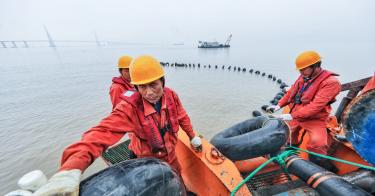The Sino-U.S. “cold tech war” is reaching new heights—or rather depths—as tensions are building under the sea. First it was semiconductors. Now it’s submarine cables.
Undersea cables, unseen and often ignored, are essential to daily life and critical to U.S. national security. Over 97 percent of global data traffic travels through a network of cables that sit atop the seabed of the world’s oceans. Those same cables transmit upwards of $10 trillion in financial transactions every day and are a central component of the American military’s network-centric warfare operations.
In the current geopolitical climate, submarine cable financing and construction is about far more than turning profits. Control of cable networks means control of information—a center of gravity in modern conflict. Now, national governments are inserting themselves in bidding wars between private firms to gain a strategic edge over their adversaries in the information sphere. Nowhere is such competition more apparent than between the United States and China.
>>> Winning the New Cold War: A Plan for Countering China
The Chinese Communist Party (CCP) openly monitors and regulates the flow of information between its citizens, and increasingly, the same is true worldwide. In fact, the CCP mandates that Chinese-based fiber-optic companies conduct surveillance on its behalf both at home and abroad. The U.S. government has since limited the use of equipment from these businesses on American shores, stating that its authorization poses “an unacceptable risk to national security.”
In 2018, a consortium including state-backed China Mobile applied to build the “Bay to Bay Express” cable, connecting Hong Kong to California. However, a Trump-era working group assessed that Hong Kong-based cables “would expose U.S. communications traffic to collection” by the Chinese Communist Party. Approvals for cable landings linking U.S. soil to Hong Kong were therefore blocked, forcing China to abandon the project.
Following the collapse of several similar deals in the Pacific, China’s undersea cable industry turned toward Africa and Eurasia—markets that receive low levels of American investment and are therefore open to Chinese capital. Already part of the “Belt and Road Initiative,” President Xi Jinping’s colossal investment strategy to enhance the CCP’s political influence in the developing world, some of these countries were more receptive to becoming part of China’s cable network.
In 2021, China Mobile, Facebook, and others constructed a submarine cable surrounding the African continent. The cable advances China’s “Digital Silk Road,” the technological component of Beijing’s Belt and Road Initiative that will expand its global infrastructure network. Additionally, notorious tech giant Huawei’s cleverly rebranded subsidiary HMN Tech laid a cable in December 2022 known as “PEACE,” linking Kenya and Pakistan to France. The PEACE cable extends through the Suez Canal—a vital waterway connecting the Indian Ocean to the Mediterranean Sea along China’s “Maritime Silk Road” route.
The U.S. is combating CCP fiber-optic influence at its source—the bidding process. In February 2023, a U.S. government push successfully removed HMN Tech, China Telecom, and China Mobile from the South East Asia-Middle East-West Europe 6 (Sea-Me-We 6) project, a proposed 12,000-mile cable that will connect southeast Asia to western Europe.
Unfortunately, that success was short-lived. Two months later, China Telecom and China Unicom announced plans to finance a $500 million undersea cable, calling it Europe-Middle East-Asia, or EMA. This undersea cable will rival the Sea-Me-We 6, stretching along a remarkably similar route and landing at many of the same locations.
>>> China Is Determined To Push Its Way Into the Arctic
The U.S. and China are now engaged in a full-fledged tit-for-tat cable competition, launching new projects of their own and disrupting projects started by the other. For instance, the United States, Japan, and Australia signed an agreement with Micronesia in June of this year to construct an undersea cable for their island chain. These islands are situated in the western Pacific—an area where Washington and Beijing are both vying for influence. The U.S. successfully convinced the Micronesians to reject a similar offer from the Chinese in 2021, warning that the CCP would likely use a Chinese-laid cable to collect intelligence.
Capitol Hill is also taking steps to counter China’s ability to build undersea cables. In early 2023, House Republicans led by Representative Brian Mast (FL-21) drafted a bill that “would require the Biden Administration to develop a strategy to limit foreign adversaries like China from accessing goods and technologies capable of supporting undersea cables.” The legislation, titled the Undersea Cable Control Act, unanimously passed the House in March, and is expected to pass in the Senate.
Submarine cable competition between the United States and China has serious implications for today’s information war. If China and the U.S. continue to bid against each other, countries will be forced to choose between their cable networks, forming a “digital Iron Curtain” that splits the internet ecosystem in two. Just like Cold War-era Germany, a boundary line will separate two ideological worlds. This time though, the Berlin Wall will be invisible, and the divide will not be one of peoples, but of information itself.
This piece originally appeared in RealClear Defense



